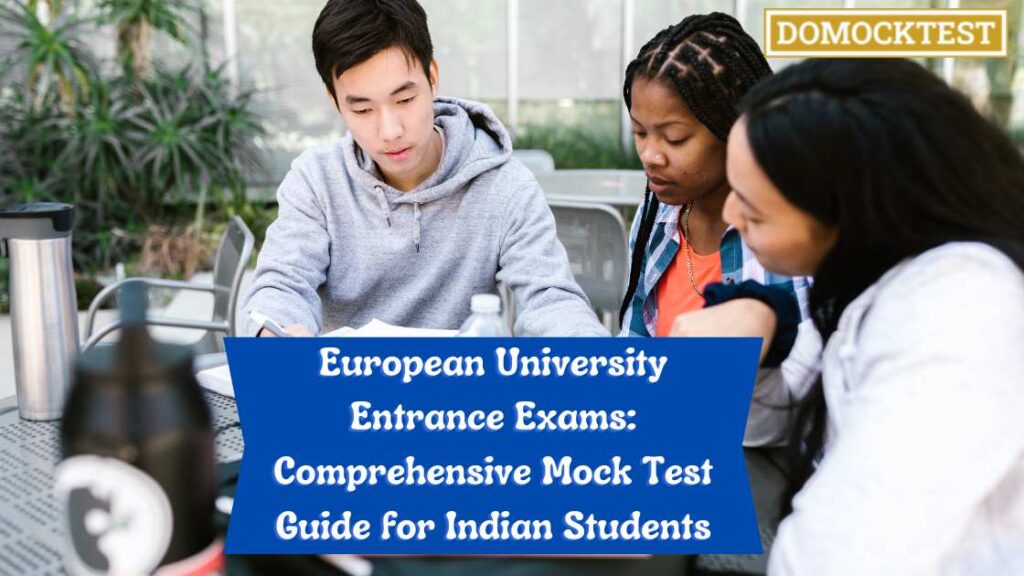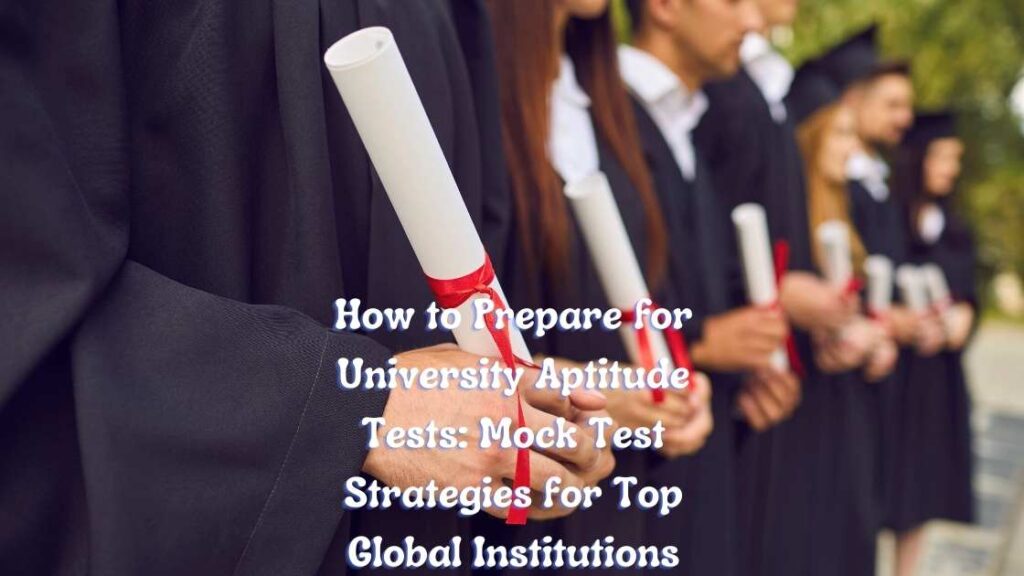Published on: April 26, 2025
For Indian students aspiring to study at prestigious European universities, navigating the landscape of entrance exams is a critical step toward securing admission. European institutions, renowned for their academic excellence and diverse programs, often require standardized tests or university-specific entrance exams to assess candidates’ readiness for higher education. These exams vary across countries and institutions, presenting unique challenges for Indian students accustomed to India’s competitive exam systems like JEE or NEET. Mock tests are indispensable tools for mastering these exams, offering opportunities to simulate test conditions, refine strategies, and build confidence. This comprehensive guide explores the key European university entrance exams, the role of mock tests, and tailored strategies to help Indian students excel in their applications.
Understanding European University Entrance Exams
European universities employ a range of entrance exams, from standardized tests like the SAT, ACT, or BMAT to institution-specific assessments. Unlike India’s centralized exams, European systems are decentralized, with requirements varying by country, university, and program. Below is an overview of common exams relevant to Indian students:
1. Standardized Tests
- SAT (Scholastic Assessment Test):
- Purpose: Widely accepted by universities in countries like the Netherlands, Germany, and Italy for undergraduate programs.
- Structure: Evidence-Based Reading and Writing, Math, and an optional Essay.
- Scoring: 400–1600 (200–800 per section).
- Duration: Approximately 3 hours (plus 50 minutes for the Essay).
- Key Feature: Multiple-choice format with a focus on critical thinking and problem-solving.
- ACT (American College Testing):
- Purpose: Accepted by some European universities as an alternative to the SAT.
- Structure: English, Math, Reading, Science, and an optional Writing section.
- Scoring: 1–36 (composite score averaged from four sections).
- Duration: Approximately 3 hours (plus 40 minutes for Writing).
- Key Feature: Emphasizes scientific reasoning, appealing to STEM applicants.
- IELTS/TOEFL (English Proficiency Tests):
- Purpose: Required by most European universities to assess English language skills for non-native speakers.
- Structure: Reading, Writing, Listening, and Speaking.
- Scoring: IELTS (0–9 band); TOEFL (0–120).
- Duration: IELTS (2 hours 45 minutes); TOEFL (3 hours).
- Key Feature: Mandatory for Indian students unless prior education was in English.
2. Medicine and Health Sciences Exams
- BMAT (BioMedical Admissions Test):
- Purpose: Required for medical programs at institutions like the University of Oxford, Cambridge, and select universities in the Netherlands and Italy.
- Structure: Section 1 (Aptitude and Skills), Section 2 (Scientific Knowledge), Section 3 (Writing Task).
- Scoring: Sections 1 and 2 (1–9); Section 3 (0–5 for content, A–E for quality).
- Duration: 2 hours.
- Key Feature: Tests critical thinking, scientific knowledge, and essay writing under time pressure.
- IMAT (International Medical Admissions Test):
- Purpose: Entrance exam for English-taught medical programs in Italy (e.g., University of Milan, Rome).
- Structure: Logical Reasoning, General Knowledge, Biology, Chemistry, Physics, Math.
- Scoring: 90 points (1.5 for correct, -0.4 for incorrect, 0 for unanswered).
- Duration: 100 minutes.
- Key Feature: Highly competitive, with limited seats for international students.
3. University-Specific Exams
- Oxbridge Assessments (UK):
- Purpose: Required for undergraduate programs at Oxford and Cambridge (e.g., TSA for PPE, MAT for Mathematics).
- Structure: Varies by subject (e.g., multiple-choice, problem-solving, essays).
- Scoring: Varies (e.g., TSA: 0–100; MAT: 0–100).
- Duration: 1–2 hours, depending on the test.
- Key Feature: Subject-specific, designed to assess aptitude beyond school curricula.
- LNAT (National Admissions Test for Law, UK):
- Purpose: Required for law programs at universities like Oxford, LSE, and UCL.
- Structure: Section A (Multiple-Choice Questions), Section B (Essay).
- Scoring: Section A (0–42); Section B (qualitative assessment).
- Duration: 2 hours 15 minutes.
- Key Feature: Tests critical thinking and argumentative writing.
- European University-Specific Tests:
- Examples include the UvA (University of Amsterdam) entrance exams for selective programs or TUM (Technical University of Munich) aptitude assessments.
- Structure and scoring vary, often involving subject-specific questions or interviews.
Indian students must research program-specific requirements, as some universities (e.g., in Germany or France) may prioritize academic transcripts or interviews over standardized tests. Mock tests are critical for mastering these diverse formats and aligning performance with competitive benchmarks.
The Role of Mock Tests in Preparation
Mock tests simulate the actual exam experience, helping students build familiarity with question types, manage time, and reduce test-day anxiety. For Indian students, who may face cultural and curricular differences in European exams, mock tests serve as a bridge to adapt to unfamiliar formats. Key benefits include:
- Diagnostic Assessment: Identify strengths and weaknesses in specific sections or subjects.
- Time Management: Practice pacing to complete exams within strict time limits.
- Format Familiarity: Understand question styles (e.g., BMAT’s scientific reasoning or IMAT’s negative marking).
- Score Tracking: Monitor progress toward target scores for competitive programs.
- Confidence Building: Simulate test-day pressure to enhance mental resilience.
Official practice tests (e.g., College Board for SAT, Cambridge Assessment for BMAT) are the most accurate, but third-party platforms like Kaplan, Princeton Review, and Magoosh offer valuable supplementary mock tests.
Mock Test Strategies for Key Exams
Effective mock test preparation requires tailored strategies for each exam, accounting for its structure, scoring, and content. Below are detailed strategies for Indian students targeting European university entrance exams.
1. SAT/ACT Mock Test Strategies
The SAT and ACT are widely accepted by European universities, particularly in the Netherlands and Germany. Indian students, accustomed to rigorous math curricula, may find the Math sections manageable but struggle with Reading and Writing due to unfamiliar vocabulary or cultural contexts.
- Start with a Diagnostic Test:
- Take a full-length, timed SAT or ACT practice test from the College Board or ACT.org. This establishes a baseline score (e.g., 1200+ for SAT or 27+ for ACT for competitive programs).
- Analyze results to identify weak areas (e.g., Reading comprehension or Math word problems).
- Set a target score based on university requirements (e.g., 1400+ for Erasmus University Rotterdam).
- Section-Specific Preparation:
- Reading/Writing (SAT) or English/Reading (ACT):
- Practice skimming passages for main ideas and key details. Indian students should focus on unfamiliar topics (e.g., American history or literature).
- Build vocabulary using flashcards or apps like Quizlet to tackle SAT’s Evidence-Based Reading questions.
- Mock Test Tip: Allocate 1–1.5 minutes per question in Reading to maintain pacing.
- Math:
- Review algebra, geometry, and data analysis, which align with Indian Class 11–12 syllabi. Focus on word problems, which may differ from Indian exam styles.
- Practice calculator and non-calculator sections (SAT) to adapt to time constraints.
- Mock Test Tip: Use mock tests to practice translating complex word problems into equations within 1–2 minutes.
- Science (ACT):
- Practice interpreting graphs, tables, and experimental data. Indian students may need to strengthen scientific reasoning, as this section is less common in Indian exams.
- Mock Test Tip: Aim for 50–60 seconds per question to complete the section on time.
- Essay/Writing (Optional):
- Practice structuring essays with clear arguments and evidence. For SAT, focus on analyzing provided texts; for ACT, develop persuasive essays.
- Mock Test Tip: Use mock tests to write essays within 50 minutes (SAT) or 40 minutes (ACT), aiming for a score of 6+/8 (SAT) or 8+/12 (ACT).
- Reading/Writing (SAT) or English/Reading (ACT):
- Simulate Test Conditions:
- Take weekly mock tests under timed conditions, using a quiet environment and adhering to breaks (10 minutes after two sections for SAT; 10 minutes after Math for ACT).
- Review errors thoroughly, focusing on why mistakes occurred (e.g., misreading questions or time pressure).
- Track Progress:
- Complete 5–7 mock tests over 2–3 months. Aim for consistent scores at or above your target by the final tests.
- Adjust study plans based on mock test data (e.g., intensify Reading practice if scores lag).
2. BMAT Mock Test Strategies
The BMAT is critical for medical aspirants targeting programs in the UK or Italy. Its fast-paced format and scientific focus challenge Indian students, who may be more familiar with fact-based exams like NEET.
- Diagnostic Test:
- Take a BMAT past paper from Cambridge Assessment Admissions Testing (free on their website). This reveals strengths in scientific knowledge (Section 2) versus weaknesses in aptitude (Section 1) or writing (Section 3).
- Set a target score (e.g., 5.5+ in Sections 1 and 2, 3.5+/A in Section 3 for competitive programs like Oxford).
- Section-Specific Strategies:
- Section 1 (Aptitude and Skills):
- Practice critical thinking, problem-solving, and data analysis questions. Indian students should focus on unfamiliar formats like verbal reasoning.
- Mock Test Tip: Allocate ~1 minute per question (32 questions in 60 minutes) to maintain pacing.
- Section 2 (Scientific Knowledge):
- Review biology, chemistry, physics, and math up to GCSE level (equivalent to Indian Class 10). Use BMAT Section 2 guides to align with the syllabus.
- Practice applying knowledge to novel scenarios, unlike the rote learning common in Indian exams.
- Mock Test Tip: Aim for 1–1.5 minutes per question (27 questions in 30 minutes).
- Section 3 (Writing Task):
- Practice writing concise essays (one A4 page) addressing ethical, scientific, or philosophical prompts. Focus on clarity and balanced arguments.
- Mock Test Tip: Use mock tests to write essays within 30 minutes, aiming for logical structure and grammatical accuracy.
- Section 1 (Aptitude and Skills):
- Simulate Time Pressure:
- The BMAT’s tight timing (2 hours for three sections) requires practice. Take full-length mock tests weekly, adhering to section time limits.
- Review errors to address time management issues (e.g., spending too long on complex Section 1 questions).
- Progress Monitoring:
- Complete 4–6 mock tests, using past papers and third-party resources like Kaplan. Aim for consistent improvement in Section 1 and 2 scores.
- Seek feedback on Section 3 essays from teachers or peers to refine writing skills.
3. IMAT Mock Test Strategies
The IMAT is the gateway to English-taught medical programs in Italy. Its negative marking and broad syllabus (including general knowledge) pose challenges for Indian students.
- Diagnostic Test:
- Take an IMAT past paper (available on the Italian Ministry of Education website or Cambridge Assessment). Assess performance across Logical Reasoning, General Knowledge, and scientific sections.
- Target a score of 50+ for competitive universities like Milan or Rome.
- Section-Specific Strategies:
- Logical Reasoning and General Knowledge:
- Practice critical thinking and problem-solving questions. General Knowledge may cover history, literature, or current affairs, requiring Indian students to broaden their reading.
- Mock Test Tip: Allocate ~1 minute per question (22 questions in ~25 minutes).
- Scientific Sections (Biology, Chemistry, Physics, Math):
- Review Italian high school-level sciences (aligned with Indian Class 11–12). Focus on applying concepts to practical scenarios.
- Practice negative marking strategies: skip questions with low confidence to avoid penalties (-0.4 points).
- Mock Test Tip: Aim for 1–1.5 minutes per question (38 questions in ~75 minutes).
- Mock Test Tip: Use mock tests to practice guessing strategically (e.g., eliminate two options before guessing to improve odds).
- Logical Reasoning and General Knowledge:
- Simulate Exam Conditions:
- Take weekly mock tests under timed conditions (100 minutes total). Practice with negative marking to refine answer selection.
- Review incorrect answers to understand content gaps or misinterpretations.
- Track Improvement:
- Complete 5–7 mock tests, using past papers and resources like Medic Mind or IMAT Buddy. Aim for scores approaching 55–60 by the final tests.
- Adjust study focus based on weak areas (e.g., General Knowledge or Physics).
4. Oxbridge and LNAT Mock Test Strategies
Oxford, Cambridge, and law programs (via LNAT) require subject-specific or critical thinking tests, which differ from Indian exam formats.
- Diagnostic Test:
- Take a past paper for the relevant test (e.g., TSA, MAT, LNAT) from official websites. Identify strengths (e.g., Math for MAT) and weaknesses (e.g., essay writing for LNAT).
- Target competitive scores (e.g., 70+ for TSA, 25+ for LNAT Section A).
- Section-Specific Strategies:
- TSA (Thinking Skills Assessment):
- Practice critical thinking and problem-solving questions. Indian students should focus on verbal reasoning, which may be less familiar.
- Mock Test Tip: Allocate ~1 minute per question (50 questions in 90 minutes).
- MAT (Mathematics Admissions Test):
- Review advanced math topics (e.g., calculus, number theory). Practice long-form problem-solving under time constraints.
- Mock Test Tip: Aim for 4–5 minutes per question (10 questions in 2.5 hours).
- LNAT:
- Practice multiple-choice questions (Section A) on reading comprehension and logical reasoning. For Section B, write essays on abstract topics.
- Mock Test Tip: Allocate 95 minutes for Section A (42 questions) and 40 minutes for Section B (one essay).
- TSA (Thinking Skills Assessment):
- Simulate Conditions:
- Take mock tests under timed conditions, mimicking the exam’s structure. Review errors to refine strategies (e.g., skimming passages for LNAT).
- Practice essays for LNAT or Oxbridge tests, seeking feedback on clarity and argumentation.
- Progress Tracking:
- Complete 4–6 mock tests, using official past papers and third-party resources. Aim for consistent scores at or above target levels.
- Adjust preparation based on mock test insights (e.g., intensify essay practice for LNAT).
Integrating Mock Test Results into Your Application Strategy
High entrance exam scores are critical but must complement a strong overall application. Indian students can use mock test performance to enhance their candidacy:
- Align Scores with University Requirements:
- Research target programs’ score expectations (e.g., 1400+ SAT for Bocconi, 6.0+ BMAT for Cambridge Medicine).
- Use mock test scores to decide which exam to prioritize (e.g., SAT vs. ACT) based on strengths.
- Balance Preparation with Academics:
- Dedicate 2–3 months to test prep while maintaining strong Class 12 performance, as European universities value academic transcripts.
- If mock test scores are below target, consider delaying exams to strengthen preparation.
- Address Language Requirements:
- Use IELTS/TOEFL mock tests to ensure a competitive score (e.g., IELTS 7.0+ or TOEFL 100+). Practice Speaking sections to overcome hesitation common among Indian students.
- Plan Retakes:
- If mock test scores are significantly below target, schedule a retake. Most exams allow multiple attempts (e.g., SAT unlimited, BMAT once per cycle).
- Use mock tests to confirm readiness before retesting.
Common Pitfalls and How to Avoid Them
- Cultural and Format Unfamiliarity:
- Indian students may struggle with critical thinking or essay-based questions due to rote-learning backgrounds.
- Solution: Practice with official mock tests and read Western academic texts to adapt to question styles.
- Time Management Issues:
- Strict time limits (e.g., IMAT’s 100 minutes) can overwhelm students used to longer Indian exams.
- Solution: Take timed mock tests weekly to build pacing skills.
- Neglecting General Knowledge:
- Exams like IMAT require broad knowledge, which Indian students may overlook.
- Solution: Read international news and history texts; use mock tests to identify gaps.
- Underestimating Essays:
- Tests like BMAT, LNAT, or SAT/ACT essays require concise, structured writing, which may be unfamiliar.
- Solution: Practice essays during mock tests and seek feedback from mentors.
Resources for Mock Tests
- Official Resources:
- SAT: College Board (free practice tests, Khan Academy partnership).
- ACT: ACT.org (free and paid practice tests).
- BMAT/IMAT: Cambridge Assessment Admissions Testing (past papers).
- LNAT: LNAT.ac.uk (sample tests).
- Oxbridge: University websites (TSA, MAT past papers).
- IELTS/TOEFL: British Council, ETS (free and paid practice tests).
- Third-Party Resources:
- Kaplan: Comprehensive mock tests for SAT, ACT, BMAT, and more.
- Princeton Review: Detailed score reports and practice tests.
- Magoosh: Affordable SAT, ACT, and TOEFL mock tests.
- Medic Mind/IMAT Buddy: Specialized IMAT and BMAT practice.
- Study Tools:
- SAT/ACT: Official guides, Barron’s prep books.
- BMAT/IMAT: BMAT 400 Practice Questions, IMAT past paper compilations.
- LNAT: LNAT Practice Papers by Mark Shepherd.
- IELTS/TOEFL: Cambridge IELTS books, ETS TOEFL Official Guide.
Conclusion
For Indian students, European university entrance exams represent both a challenge and an opportunity to access world-class education. Mock tests are essential for mastering these exams, helping students adapt to unfamiliar formats, manage time, and achieve competitive scores. By starting with diagnostic tests, focusing on section-specific strategies, simulating test conditions, and tracking progress, students can optimize their performance. Integrating mock test results into a broader application strategy ensures a compelling candidacy for top European institutions. With disciplined preparation and strategic use of mock tests, Indian students can unlock doors to prestigious universities and embark on transformative academic journeys.


